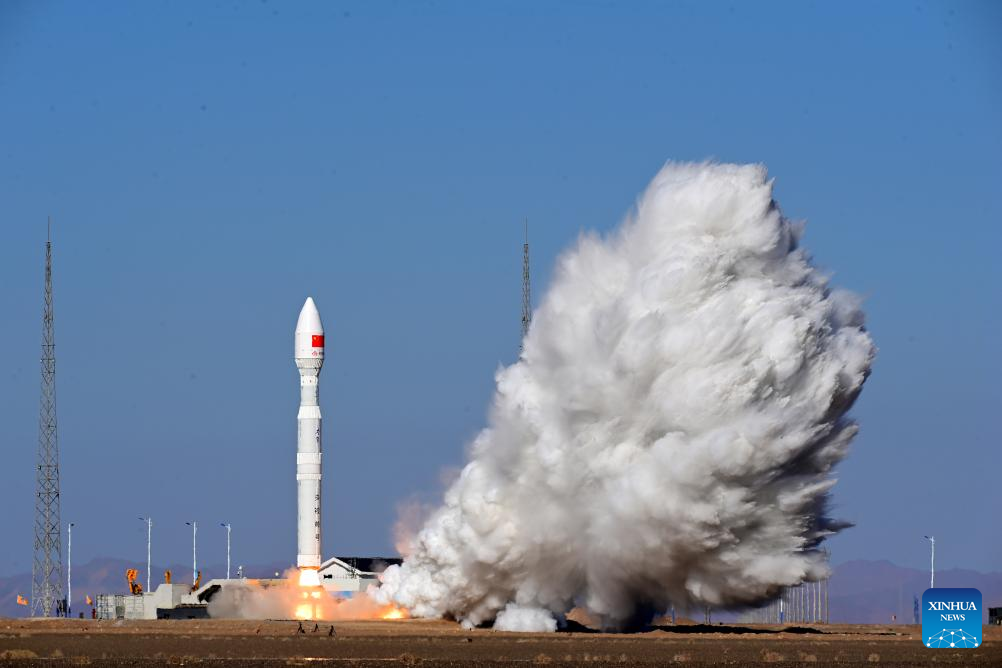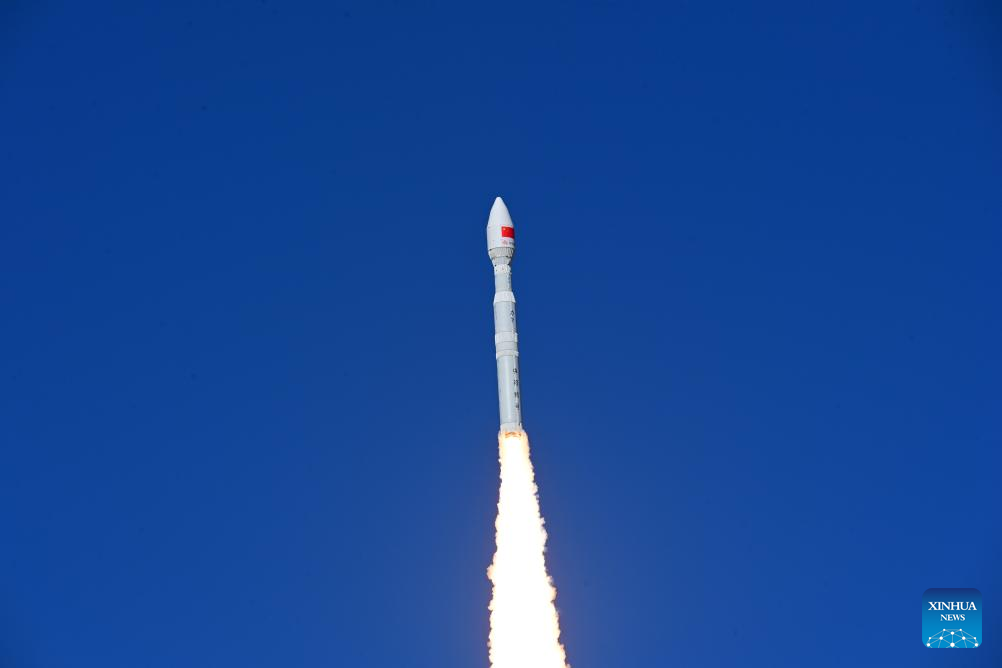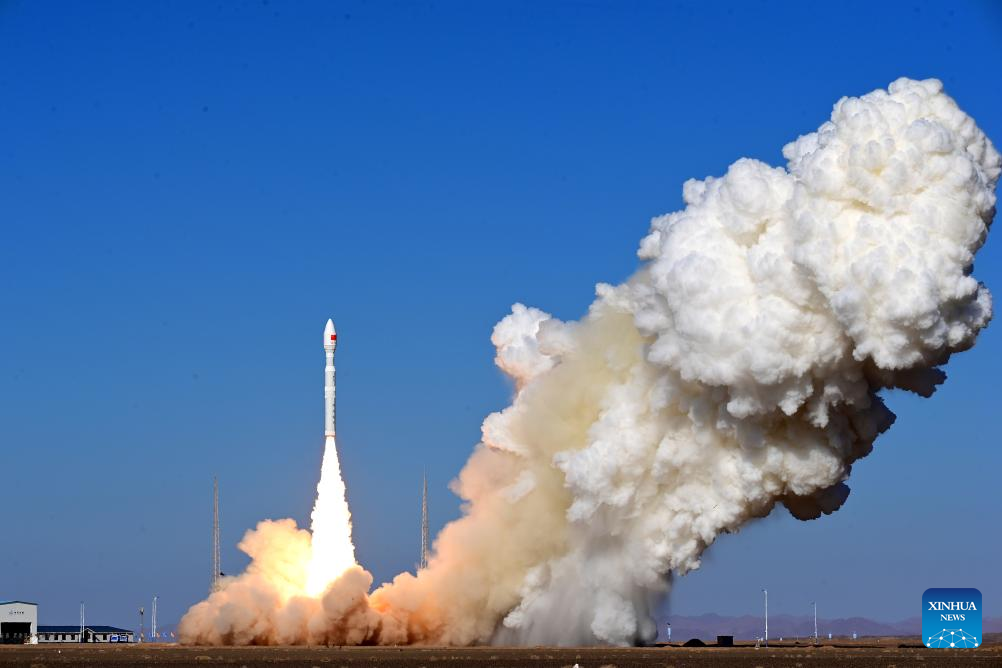
A Lijian-1 Y5 commercial carrier rocket with 15 satellites onboard blasts off from a commercial aerospace innovation pilot zone in northwest China, Nov. 11, 2024. The rocket blasted off at 12:03 p.m. (Beijing Time) on Monday and sent the 15 satellites, including the Jilin-1 Gaofen series, Yunyao-1 series, Xiguang-1 series, and a remote-sensing satellite launched for Oman, into their planned orbits. (Photo by Wang Jiangbo/Xinhua)
JIUQUAN, Nov. 11 (Xinhua) -- China on Monday launched the Lijian-1 Y5 commercial carrier rocket with 15 satellites onboard.
The rocket blasted off at 12:03 p.m. (Beijing Time) from a commercial aerospace innovation pilot zone in northwest China and sent the 15 satellites, including satellites from the Jilin-1 Gaofen series, Yunyao-1 series, Xiguang-1 series and a remote-sensing satellite launched for Oman, into their planned orbits.
The Lijian-1 carrier rocket was developed by CAS Space, a commercial spaceflight company established by the Institute of Mechanics under the Chinese Academy of Sciences. This rocket series completed its maiden flight on July 7, 2022, and has now launched a total of 57 satellites in the course of five flight missions.
With a length of 30 meters, a takeoff weight of 135 tonnes, and a takeoff thrust of 200 tonnes, Lijian-1 can send a payload of 1.5 tonnes to a 500-km sun-synchronous orbit, or a payload of 2 tonnes to low Earth orbit.
The Lijian-1 Y5 carrier rocket uses a payload fairing with a diameter of 3.35 meters to accommodate the larger space required by satellites. Payload fairing configuration can be adjusted according to the payload capacity and space requirements of satellites in future missions.
The Yunyao-1 series onboard the rocket consists of six satellites, which are primarily designed for atmospheric detection or monitoring environmental hot spots.
The remote-sensing satellite launched for Oman utilized artificial intelligence to calculate its load. The intelligent operating system of the satellite can conduct in-orbit processing and analysis, and it can be applied in detailed land surveys, urban planning, forest surveys and disaster monitoring.
This mission marks the first time for Chinese commercial space enterprises to provide launch services to international users, highlighting that the Lijian-1 carrier rocket has officially entered the international commercial space market, said Shi Xiaoning, chief designer of the rocket.
Shi noted that the cost performance and product reliability of the rocket have been recognized by the international market. ■

A Lijian-1 Y5 commercial carrier rocket with 15 satellites onboard blasts off from a commercial aerospace innovation pilot zone in northwest China, Nov. 11, 2024.
The rocket blasted off at 12:03 p.m. (Beijing Time) on Monday and sent the 15 satellites, including the Jilin-1 Gaofen series, Yunyao-1 series, Xiguang-1 series, and a remote-sensing satellite launched for Oman, into their planned orbits. (Photo by Wang Jiangbo/Xinhua)

A Lijian-1 Y5 commercial carrier rocket with 15 satellites onboard blasts off from a commercial aerospace innovation pilot zone in northwest China, Nov. 11, 2024.
The rocket blasted off at 12:03 p.m. (Beijing Time) on Monday and sent the 15 satellites, including the Jilin-1 Gaofen series, Yunyao-1 series, Xiguang-1 series, and a remote-sensing satellite launched for Oman, into their planned orbits. (Photo by Wang Jiangbo/Xinhua)

A Lijian-1 Y5 commercial carrier rocket with 15 satellites onboard blasts off from a commercial aerospace innovation pilot zone in northwest China, Nov. 11, 2024.
The rocket blasted off at 12:03 p.m. (Beijing Time) on Monday and sent the 15 satellites, including the Jilin-1 Gaofen series, Yunyao-1 series, Xiguang-1 series, and a remote-sensing satellite launched for Oman, into their planned orbits. (Photo by Wang Jiangbo/Xinhua)



